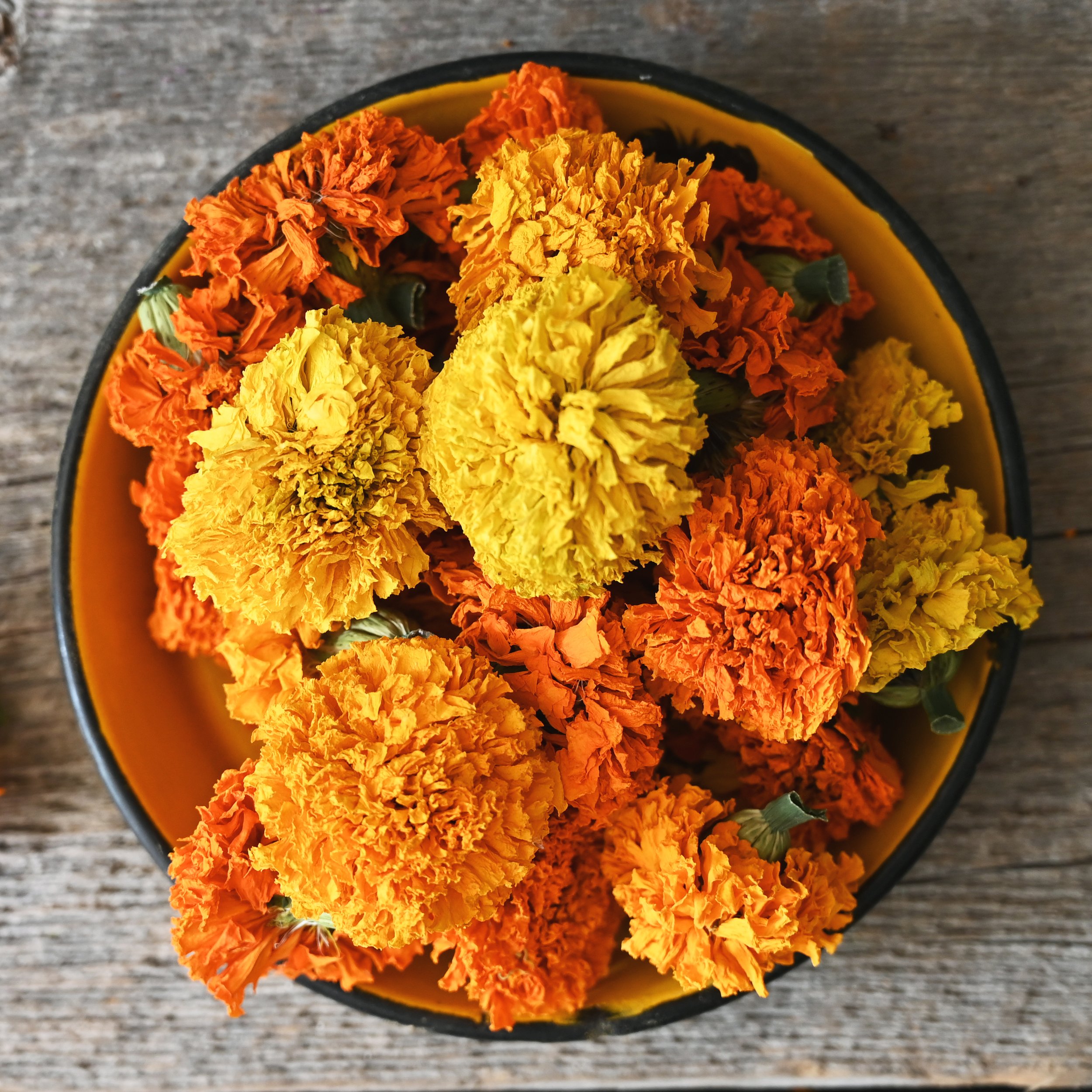Natural Dye Cultivation Series: Marigolds
Marigolds are native to Mexico and have become naturalized in regions all over the world. There are over fifty species but the most common cultivated varieties are the African (Tagetes erecta) and French (Tagetes patula) varieties both of which are annuals and can be used as natural dye. They’re pretty low-key to grow from seed and are readily available to source from nurseries as seedlings in the spring.
quick facts:
Annual
Germination: 7-10 days
Seed planting depth: barely cover
Light: Full sun
Spacing: 12”
Days to flower from seed: 60-70
Height & Width: 36” x 18”
CULTIVation
We grow marigolds as row crops here on our farm and have experimented with both direct seeding them into the garden and transplanting them out. I’ve tried a few different varieties and so far I prefer the open-pollinated variety Crackerjack (Tagetes erectus). The plants quickly become pretty massive, growing up to nearly 4’ in height, and are prolific producers of long-stemmed, orange, golden, or lemon yellow blooms averaging about 3” in diameter. We have a short growing season here in the high desert so I’ve had better luck with the transplanting method. In our zone (5a) I begin the seeds indoors under grow lights in mid-April, about 6 weeks before our average last frost date of June 1. After the danger of frost has passed I transplant the seedlings out, spacing them about 18” apart to give them plenty of room to grow. Marigolds are robust plants and acclimate relatively easily once transplanted. For maximum blooms, I snap off the first flower bud that develops from the center stem as soon as I first notice it. This encourages the plant to make a whole bunch more blooms rather than to put its energy into that one first bloom.
HARVESTING
Once the flowers are robust and fully formed to their maximum potential, I begin harvesting them by clipping the blooms with shears leaving just a half-inch or less of stem. I walk the rows every other day during summer searching for the ripest flowers. Marigolds are ripe when the center petals are fully formed and are no longer green. I’m pretty diligent about harvesting the blooms right at peak ripeness, and also before they become overripe. This not only ensures the choicest flowers for curing but also encourages the plants to continue to produce more blooms.
CURING
Dried and properly cured flowers will keep for months and even years. Here in the southwest, we have an ideal arid climate for drying and curing. My system is simple consisting of only tiered hanging mesh drying racks (do a web search for that and you will find them) and a fan. In very humid climates I imagine a dehumidifier may be necessary. Of all the flowers I grow, marigolds take the longest to cure because they’re very dense. In sunny warm weather, they take around 10 days to dry here. During the monsoonal rain season, that dry time increases significantly. Once the flowers are fully dry I transfer them to a paper grocery bag where they hang out for at least a few weeks to further dry and cure. Once I’m certain they’re completely dried they’re ready to be sold and distributed. If you wish to avoid purchasing the mesh drying racks you can make marigold garlands by stringing the flowers to dry. A darning or tapestry needle and thinner hemp twine work well for this. Marigold garlands are certainly more pleasant to look at than mesh-tiered baskets.
DYEING
A dye bath can be set up with either fresh or dried marigolds. When working with marigolds (both fresh and dried) I don’t use WOF ratios and I don’t weigh anything out. I simply use a whole lot of marigolds and make a strong dye bath with them. I enter pre-mordanted fabric into the dye bath and hold it at a near boil for about an hour. Then I remove the fabric, enter another piece, and continue in this way working my way through the exhaust bath to create lighter depths of shades as I go. The marigold colors in the image (above right) were modified with iron. You can refer to this blog post I wrote about dyeing with flowers if you’re curious to learn more, and my book Farm & Folk Quilt Alchemy explains natural dye processes in even greater detail.
If you want to give marigolds a try you can purchase seeds in our shop!
So there you have it. Seed to dye pot magic with marigolds! Let me know if you have any questions in the comments below.






